Initiatives in FY2017
Results for the Fiscal Year 2017 and Future Plans
In fiscal year 2017, CO2 emissions (Scopes 1 and 2) at the azbil Group’s bases decreased by 43% compared with fiscal year 2006 (ended March 2007), a 49% improvement per unit sales. In addition to CO2 emissions under our control (Scope 1 and 2), we also identify CO2 emissions indirectly related to corporate activities (Scope 3), including emissions from our supply chains, in our efforts to reduce emissions through Design for the Environment and other initiatives.
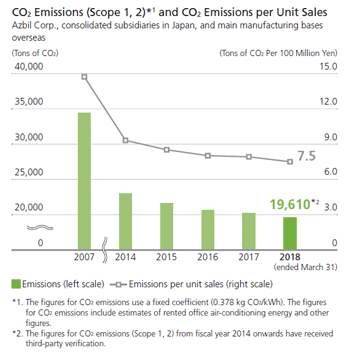
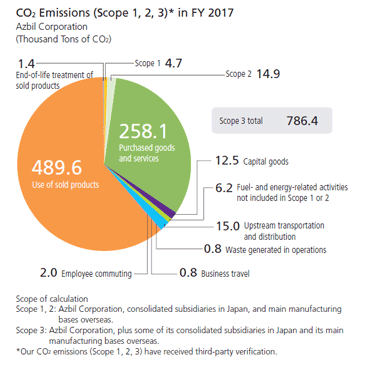
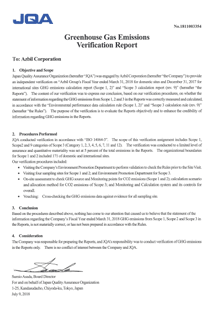
Greenhouse Gas Emissions Verification Statement
(Click here for more detail)
Initiatives in FY2017
Initiatives at the Fujisawa Technology Center
The Fujisawa Technology Center, our R&D facility, carries out a range of demonstration experiments for energy management solutions and serves as a model business site for energy conservation, activities that help us to reduce environmental impact at our customers’ sites. The technology and know-how obtained through these initiatives can be viewed by the public.
Mastering both the Physical and the Psychological
~Air Conditioning Control Experiment to Understand the Preferences of Room Occupants~
In many buildings, energy is wasted by excessively hot or cold temperatures set by occupants.
As a solution, we devised a thermal sensation voting air conditioning system (tentative name). Instead of directly setting the temperature, occupants send a signal informing the system that they feel hot or cold. They do so using a newly developed thermal sensation voting card. The system responds immediately to their temperature preference while also appropriately controlling the room environment to ensure that other people do not feel uncomfortable for an extended period.
We installed this system in Building 100 at Fujisawa Technology Center and are currently evaluating the resulting comfort level and energy efficiency. Based on analysis of the transmitted temperature sensations and of questionnaire results, we hope to have this system in operation as a service that helps to save energy and also improves productivity at customers’ sites.
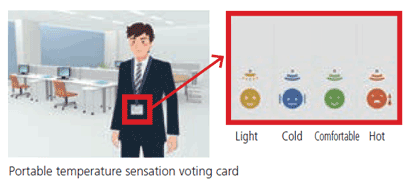
Expanding the Use of Renewable Energy
~Virtual-Power-Plant Construction Demonstration Project~
Virtual power plants are gaining attention as a way to expand the use of renewable energy, which in turn provides benefits such as mitigating climate change. A virtual power plant (VPP) functions by aggregating distributed energy resources (solar, wind, etc.).
Using a VPP to adjust the energy supply-demand balance with demand response (DR)*1 requires advanced energy management techniques. Azbil Corporation was selected to participate in the Ministry of Economy, Trade and Industry’s Virtual-Power-Plant Construction Demonstration Project. Wehave been conducting experiments at Fujisawa Technology Center since FY 2016 with our automatic DR, a program that responds to demand using automated control.
We are examining the operation of this program in real time and attempting to achieve optimal operation by means of communication between solar panels and energy storage facilities using savic-net™FX, a system that monitors and controls facilities and equipment. We ran automatic DR for an energy demand control (Adjustable Power Source I’*2) that was activated from January to February 2018 in areas served by Tokyo Electric Power Company, so we were able to test automatic DR in an actual electric power control situation.
We intend to optimize our operation and control methods not only for our own electricity and energy conservation, but also for the buildings of general electricity consumers, helping society as a whole to save energy.
*1 With DR the owners of energy resources among the energy consumers, or businesses such as Azbil, control energy resources on behalf of consumers in order to change power demand patterns.
*2 An energy demand control for the purpose of adjusting the supply-demand balance during periods of tight supply and demand. These periods are caused by such factors as severe weather conditions (extreme heat and cold), which occur about once every 10 years.
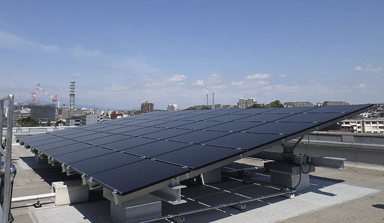
Solar panels
“Visualization” Takes Energy Efficiency to the Next Level Promotion of Sustainable Initiatives through Further Improvement of Operations
At the azbil Group’s main domestic and overseas bases, we have used our energy management solution to develop a system that manages energy use and implements energy-savings through the visualization of energy consumption in real time. Meanwhile, some say that the continuation of this initiative over many years has made it difficult to develop new measures for improving operations.
In response, we are now promoting a project throughout the azbil Group in which energy conservation personnel, company-wide environmental conservation personnel, energy conservation experts from business departments, and product and technology development personnel work together to meet the challenge of achieving sustainable energy conservation. In addition to sharing effective measures, project personnel use and analyze data collected by visualization and apply it to calorific value and electricity consumption prediction models. This assists in establishing systems for guiding improvement in HVAC equipment operation tailored to the challenges facing particular factories, in order to produce outcomes that exceed efficiency targets.
By utilizing the knowledge obtained through improvement of our own utility operations and related problem-solving in order to provide products for buildings and for small and medium- size factories, we can help to reduce the environmental impact of our customers and of society.
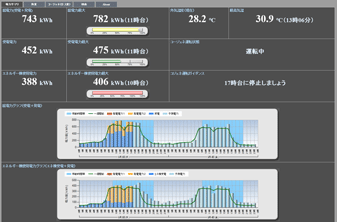
Guidance for improving heat source operation
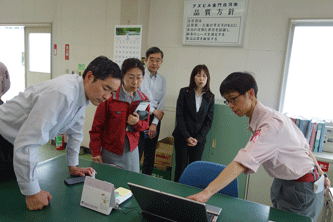
Energy conservation project
Past initiatives
Reducing Society’s Impact on the Environment
We strive not only to reduce the CO2 emissions from our own business activities, but also to provide products and solutions that help our customers to reduce their burden on the environment.
For details, see “Realizing Our Desire to Reduce Environmental Impact Through Our Core Businesses”
- Overall of Environmental Initiatives
- Contributing to the environment through our core businesses
- Reducing the environmental impact of our own business activities
